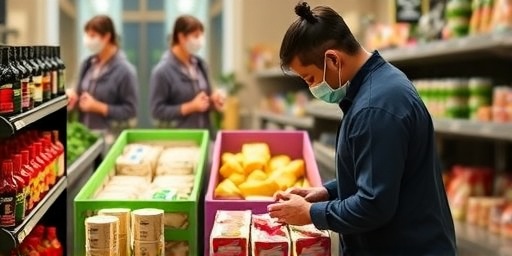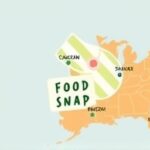As the U.S. government shutdown enters its critical phase, millions of low-income families are on the brink of losing vital SNAP benefits for November, exacerbating food insecurity and disrupting grocery spending patterns across the nation. The Supplemental Nutrition Assistance Program (SNAP), often called food stamps, supports over 42 million Americans monthly, providing an average of $250 per household to combat hunger. With federal funding at risk due to stalled budget negotiations, experts warn of immediate economic fallout in local communities reliant on this food assistance lifeline.
- SNAP Funding Freeze: How the Shutdown Disrupts Monthly Distributions
- Personal Stories Emerge: Families Bracing for Empty Pantries
- Grocery Spending Slumps: Retailers Face Uncertain Holiday Sales
- Expert Warnings: Broader Economic and Policy Ramifications
- Looking Ahead: Pathways to Restore Food Assistance and Stabilize Economies
SNAP Funding Freeze: How the Shutdown Disrupts Monthly Distributions
The mechanics of the government shutdown directly threaten SNAP benefits, as federal agencies like the U.S. Department of Agriculture (USDA) face operational halts. SNAP, administered through state agencies but funded federally, requires continuous appropriations to process and distribute electronic benefit transfer (EBT) cards. According to a USDA report from previous shutdowns, such as the 2018-2019 event, benefits can lapse after just days without funding, leaving recipients unable to purchase essentials like milk, bread, and fresh produce.
This November, the stakes are higher with inflation driving up food prices by 11.4% year-over-year, per the Bureau of Labor Statistics. For instance, a family of four relying on SNAP might see their $800 monthly allotment vanish, forcing tough choices between utilities and meals. “The shutdown isn’t just political theater; it’s a direct assault on food assistance for the most vulnerable,” said Stacy Dean, deputy undersecretary for food, nutrition, and consumer services at the USDA, in a recent briefing. Historical data from the 2013 shutdown shows that 5.8 million people experienced delays, leading to a 20% spike in emergency food bank visits.
States like California, Texas, and New York, which host over 40% of SNAP participants, are preparing contingency plans. California’s Department of Social Services has stockpiled some administrative funds, but experts estimate only a two-week buffer before lapses occur. Without intervention, the ripple effects could see grocery spending drop by $2.5 billion in the first month alone, based on USDA economic modeling.
Personal Stories Emerge: Families Bracing for Empty Pantries
Across America, the human cost of the government shutdown is becoming starkly apparent through the voices of those dependent on SNAP benefits. In Detroit, single mother Maria Gonzalez, 34, who supports two children on a part-time retail wage, shared her fears with local reporters. “SNAP is the only thing keeping us from skipping meals. If it stops, I don’t know how we’ll make it through the holidays,” Gonzalez said, highlighting the emotional toll of potential benefit lapses.
Similar narratives echo in rural areas, where access to alternative food sources is limited. In Appalachia, Kentucky, community food pantries report a 30% increase in inquiries since shutdown talks intensified. Johnathan Hale, director of the Feeding America network in the region, noted, “We’ve seen shutdowns before, but with supply chain issues lingering from the pandemic, this could be catastrophic for local economies already strained by job losses.” Hale’s organization, which distributes surplus food, anticipates serving an extra 500,000 meals if SNAP falters, but that’s merely a band-aid for the underlying crisis in food assistance.
Statistics paint a broader picture: 13% of U.S. households, or about 17 million, are food insecure, per the latest USDA data. Among them, SNAP reduces poverty by 8% and child hunger by 30%. As benefits lapse, pediatricians warn of rising malnutrition rates, with a 2022 study in the Journal of the American Medical Association linking SNAP disruptions to increased hospital admissions for diet-related illnesses. For immigrant and minority communities, who comprise 40% of SNAP users, the impact is disproportionately severe, widening existing inequities.
Grocery Spending Slumps: Retailers Face Uncertain Holiday Sales
The impending lapse in SNAP benefits is poised to hammer grocery spending, a cornerstone of the $800 billion U.S. food retail sector. Major chains like Walmart, Kroger, and Aldi, which accept EBT cards at over 250,000 locations, could see immediate revenue dips. The Food Marketing Institute estimates that SNAP drives 5-10% of total grocery sales, translating to $50 billion annually. A shutdown-induced pause could shave off $400 million weekly, per industry analysts.
In urban centers like Chicago, where SNAP recipients make up 15% of shoppers, store managers are already adjusting inventories. “We’re stocking more affordable staples, but if benefits stop, foot traffic will plummet,” said Tom Erickson, a regional director at Jewel-Osco. This slowdown not only affects big-box retailers but trickles down to suppliers—dairy farmers in Wisconsin and produce growers in Florida—who rely on steady demand. The National Grocers Association warns of potential layoffs, with 100,000 jobs at risk in the short term if the shutdown persists beyond mid-November.
Local economies, particularly in food deserts where supermarkets are scarce, face amplified strain. A report from the Brookings Institution highlights that every $1 in SNAP spending generates $1.50 in economic activity, supporting 18 jobs per $10,000 invested. In states like Mississippi and Louisiana, where poverty rates exceed 20%, the loss of this stimulus could deepen recessions, increasing reliance on state welfare programs already stretched thin.
Expert Warnings: Broader Economic and Policy Ramifications
Economists and policy experts are sounding alarms over the government shutdown’s far-reaching implications for SNAP benefits and beyond. Dr. Elaine Waxman, a senior fellow at the Urban Institute, emphasized in an op-ed for The New York Times, “This isn’t isolated to food assistance; it’s a signal of fiscal instability that could erode consumer confidence nationwide.” Her analysis projects a 0.2% GDP hit in Q4 if benefits lapse for over two weeks, compounding inflation pressures.
On the policy front, bipartisan calls for a continuing resolution grow louder. Senate Majority Leader Chuck Schumer urged swift action, stating, “We cannot let political gridlock starve our families.” Meanwhile, advocacy groups like the Center on Budget and Policy Priorities advocate for emergency waivers allowing states to issue benefits from contingency funds. However, legal hurdles remain, as seen in the 2018 shutdown when only partial exemptions were granted.
Looking at global parallels, the U.S. situation mirrors disruptions in other nations’ welfare systems during fiscal crises, such as the UK’s 2017 benefit delays that spiked food bank usage by 25%. Domestically, think tanks recommend modernizing SNAP with blockchain for faster distributions, but implementation lags amid congressional inaction.
The shutdown also intersects with ongoing debates over SNAP reforms, including work requirements pushed by some Republicans. Critics argue these could exclude 1 million more people, per Congressional Budget Office estimates, making the current crisis a preview of deeper cuts.
Looking Ahead: Pathways to Restore Food Assistance and Stabilize Economies
As negotiations intensify, the path forward for SNAP benefits hinges on congressional compromise, with a potential resolution eyed before Thanksgiving. If achieved, retroactive payments could mitigate some damage, as occurred post-2019 shutdown when $1.2 billion was disbursed swiftly. Nonprofits like No Kid Hungry are mobilizing donation drives, aiming to raise $50 million for emergency food boxes, while states explore public-private partnerships with retailers for discounted goods.
Long-term, experts call for a SNAP reserve fund, similar to unemployment insurance buffers, to insulate food assistance from shutdown volatility. The Economic Policy Institute suggests allocating $10 billion annually, which could prevent future lapses and sustain grocery spending. For local economies, bolstering community-supported agriculture (CSA) programs offers resilience, connecting families directly to farmers and bypassing retail disruptions.
Ultimately, resolving the government shutdown is crucial not just for immediate relief but for rebuilding trust in federal institutions. As families stockpile non-perishables and economies brace, the coming weeks will test America’s social safety net, underscoring the indispensable role of SNAP in fostering stability amid uncertainty.









